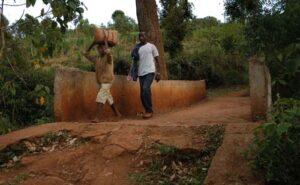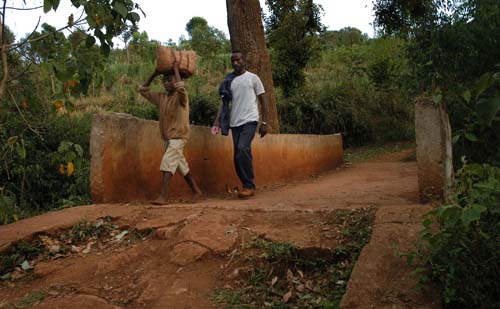
Starbucks calls its coffee worker-friendly,
but in Ethiopia, a day’s pay is a dollar
Text and photos by (APF Fellow) Tom Knudson – Bee Staff Writer
APF fellow Tom Knudson’s article on Starbucks was published jointly by the Sacramento Bee and the Alicia Patterson Foundation.
To access a video slideshow and satellite image, please go to:
http://www.sacbee.com/101/v-email/story/383817.html
Sunday, September 23, 2007
GEMADRO, Ethiopia – Tucked inside a fancy black box, the $26-a-pound Starbucks Black Apron Exclusives coffee promised to be more than just another bag of beans.
Not only was the premium coffee from a remote plantation in Ethiopia “rare, exotic, cherished,” according to Starbucks advertising, it was grown in ways that were good for the environment – and for local people, too.
Companies routinely boast about what they’re doing for the planet, in part because guilt-ridden consumers expect as much – and are willing to pay extra for it. But, in this case, Starbucks’ eco-friendly sales pitch does not begin to reflect the complex story of coffee in East Africa.
Inside the front flap of Starbucks’ box are African arabica beans grown on a plantation in a threatened mountain rain forest. Behind the lofty phrases on the back label are coffee workers who make less than a dollar a day and a dispute between plantation officials and neighboring tribal people, who accuse the plantation of using their ancestral land and jeopardizing their way of life
“We used to hunt and fish in there, and also we used to have honeybee hives in trees,” one tribal member, Mikael Yatola, said through a translator. “But now we can’t do that. …When we were told to remove our beehives from there, we felt deep sorrow, deep sadness.”
25 new U.S. stores per week
Few companies have so dramatically conquered the American retail landscape as Starbucks. Last year, the $7.8 billion company opened an average of 25 new stores a week in the United States alone. Nowhere is Starbucks a more common sight than in environmentally conscious California, which has 2,350 outlets, more than New York, Massachusetts, Florida, Oregon and Washington – Starbucks’ home state – combined.
No coffee company claims to do more for the environment and Third World farmers than Starbucks either. In full-page ads in the New York Times, in brochures and on its Web page, Starbucks says that it pays premium prices for premium beans, protects tropical forests and enhances the lives of farmers by building schools, clinics and other projects.
In places, Starbucks delivers on those promises, certainly more so than other multinational coffee companies. In parts of Latin America, for instance, its work has helped improve water quality, educate children and protect biodiversity.
Inside many Starbucks outlets across America, the African décor is hard to miss. There are photographs and watercolors of quaint coffee-growing scenes from Ethiopia to Tanzania to Zimbabwe. Yet such images clash with the reality of African life.
They don’t show the industrial arm of coffee – the large farms and estates that encroach on wild forest regions. They don’t reveal that even in the best of times in Ethiopia, the birthplace of wild coffee and the source of some of Starbucks’ priciest offerings, there is barely enough for the peasant coffee farmers who still grow most of the nation’s beans.
Even where Starbucks has built its bricks-and-mortar projects in Ethiopia, poverty remains a cornerstone of life, visible in the soot-stained cooking pots, spindly legs and ragged T-shirts, in the mad scramble of children for a visitor’s cookie or empty water bottle.
“We plant coffee, harvest coffee but we never get anything out of it,” said Muel Alema, a rail-thin coffee farmer who lives near a Starbucks-funded footbridge spanning a narrow chasm in Ethiopia’s famous Sidamo coffee-growing region.
Alema’s tattered shirt looked years old. So did his mud-splattered thongs. The red coffee berries he sold to a local buyer last fall were mixed with mountains of others, stripped of their pulp and sold as beans to distant companies – like other farmers, he did not know which ones – that made millions selling Sidamo coffee. Only $220 dribbled back to him.
This February, after Alema paid workers to pick the beans and bought grain for his family, just $110 remained – not enough, he said, to feed his wife and three children, to buy them clothes until the crop ripens again.
‘A marketing genius’
Starbucks conveys a different image on the white foil bags of Ethiopia Sidamo whole bean coffee it sells for $10.45 a pound. “Good coffee, doing good,” says lettering on the side.
“We believe there’s a connection between the farmers who grow our coffees, us and you. That’s why we work together with coffee-growing communities – paying prices that help farmers support their families…and funding projects like building a bridge in Ethiopia’s Sidamo region to help farmers get to market safely. …By drinking this coffee, you’re helping to make a difference.”
And while the Sidamo footbridge does make travel safer, it is but a simple yellow-brown concrete slab, 10 paces long.
Dean Cycon, founder of Dean’s Beans, an organic coffee company in Massachusetts, calls Starbucks “a marketing genius.”
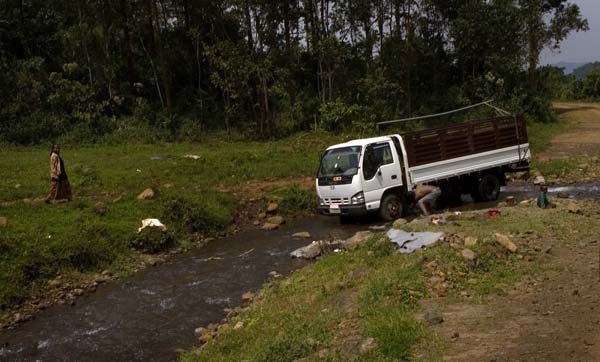
“They put out cleverly crafted material that makes the consumer feel they are doing everything possible,” Cycon said. “But there is no institutional commitment. They do it to capture a market and shut up the activists.”
Starbucks officials insist such critics have it wrong. As proof, they point to Latin America, the source of the bulk of the company’s beans.
“You go to Nariño, Colombia. We built 1,800 (coffee) washing stations and sanitation facilities and homes,” said Dub Hay, Starbucks senior vice president for global coffee procurement. “It’s literally changed the face of that whole area.”
“The same is true throughout Latin America,” Hay added. “They call it the Starbucks effect.”
Starbucks’ dealings in Latin America have drawn some fire. Near the El Triunfo Biosphere Reserve in Chiapas, Mexico, for instance, farmers cut off relations about three years ago over a dispute about selling to an exporter instead of directly to Starbucks. The new arrangement, farmers said, would drain profits from peasant growers.
Starbucks, the farmers charged in a memo to coffee buyers, was supporting “a pseudo-fair trade system, adapted to their own neo-liberal interests, to dismantle structures and advances that we have made.”
In an e-mailed response to The Bee, Starbucks vice president for global communications, Frank Kern, wrote that the Chiapas farmers were ultimately “given the opportunity to ship directly to us as they requested, but they were unable to manage it.”
Sharper focus on Africa
In Ethiopia, Starbucks says, it spent $25,000 on three footbridges in 2004. The company estimates the structures are used by 70,000 farmers and family members – about 1 percent of those who depend upon coffee for income. Some Ethiopian coffee leaders say there is a better way to help.
“If we are paid a (coffee) price which is decent, the people can make the bridge on their own,” said Tadesse Meskela, general manager of the Oromia Coffee Farmers’ Cooperative Union of 100,000 farmers, which has sold to Starbucks. “We don’t have to be always beggars.”
Starbucks won’t disclose what it pays for Ethiopian coffee. Instead, it lumps its purchases together into a global average, which last year was $1.42 a pound, 16 cents more than the Fair Trade minimum. Much of that money, though, never makes it into the pockets of farmers but instead is siphoned off by buyers, processors and other middlemen.
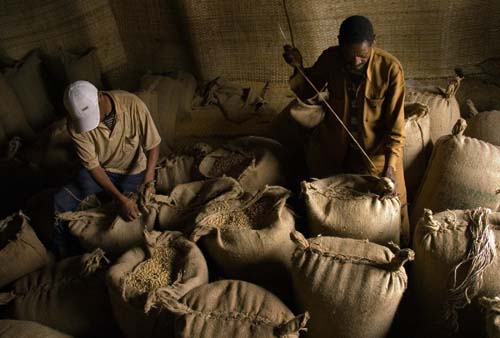
Starbucks executives say they want to shrink that supply chain. “You end up at least five levels removed from the farmer and that’s where the money goes,” said Hay. “And that’s a shame.” Hay said that as the company buys more coffee from Africa – it plans to double its purchases there to 36 million pounds by 2009 – the commerce will spur more progress.
“That’s our goal,” Hay said. “Africa is 6 percent of our purchases. … Seventy percent is from Latin America. So that’s where our money has gone.”
Making an impact in Ethiopia is undeniably a challenge. Good roads, electricity, potable water don’t exist in many places. The climate is often hostile. There are ethnic conflicts, border disputes and rebel movements, and a sea of young faces that gather every time a car stops.
Since 1990, Ethiopia’s population has jumped from 52 million to about 80 million: two new Los Angeleses. The more people, the less there is to go around. Ethiopia’s per capita annual income is only $180, one of the lowest on Earth.
The environment is hurting, too, as coffee and tea plantations – as well as peasant farmers – spread into once wild areas, raising concern about the demise of one of the country’s natural treasures: its biologically rich southwestern rain forest.
However, Samuel Assefa, the Ethiopian ambassador to the United States, said human suffering must be taken into consideration, too.
“We have a population of more than 80 million people, many of them living in rural and impoverished circumstances,” he wrote in an e-mail. “Returning all cleared land to rain forest might be a victory for some extreme environmentalists, but it would condemn millions of my fellow citizens to starvation.”
Atonement in a cup
Starbucks has bought coffee from Africa for years. But now it is expanding rapidly there because it wants more of the continent’s high-quality arabica beans. In Ethiopia alone, Starbucks purchases jumped 400 percent between 2002 and 2006.
While Starbucks is rapidly cloning retail outlets globally, 79 percent of its revenue last year was made in one caffeine-crazed country: the United States. With just 5 percent of the world’s people, the United States drinks one-fifth of its coffee, more than any other nation.

Thanks largely to Starbucks, coffee is no longer just coffee. Now it is a vanilla soy latte, a java chip Frappuccino, a grande zebra mocha or – if you’re feeling guilty – a Fair Trade-certified, bird-friendly, shade-grown caramel macchiato.
Starbucks did not pioneer the push for more equitable, conservation-based coffee. But it has woven the theme into everything from the earthy feel of its stores to its own certification program – called Coffee and Farmer Equity practices, or C.A.F.E. – that rewards farmers for meeting social and environmental goals.
“Social justice is becoming increasingly important to consumers,” said industry analyst Judith Ganes-Chase as she flashed slides across a screen at a Long Beach coffee conference. One slide read: “Fair Trade is absolution in a cup.”
Atonement, though, is not as simple as it may seem.
“It’s very comfortable to believe Starbucks is doing the right thing – and to some degree, they are,” said Eric Perkunder, a Seattle resident who worked as a Starbucks environmental manager in the 1980s and ’90s. “They lull us into complacency. The stores are comfortable. You see pictures of people from origin countries. You believe certain things they are telling you. But there’s more to the story.”
Dirt road, stick huts
Part of that story lies in the southwestern corner of Ethiopia, in a swath of mountains not far from the Sudan border. There, a dirt road snakes through one of the country’s largest coffee plantations – the Ethiopia Gemadro Estate – and comes to a halt in a dense mat of reeds and grasses.
A narrow path winds through the thicket and spills out into a clearing of stick huts. This is the home of an African Sheka tribe that for generations has lived off the land – catching fish, gathering wild honey and trapping animals in the forest. They call themselves the Shabuyye.
“The land over there used to belong to our forefathers,” said Yatola, the tribal member in his 20s, as he nodded toward the plantation.
Conflict with local people and tribes is growing across southwest Ethiopia as coffee and tea plantations spread into the region under the government’s effort to sow more development. At Gemadro, 2,496 acres of coffee were planted from 1998 to 2001 on land the company obtained from the government in a countylike jurisdiction called the Sheka Zone.
“One of Ethiopia’s last remaining forests, Sheka Forest, is under huge pressure. … The rate of deforestation is now increasing and threatens the forest biodiversity … and the very livelihood” of forest-dwelling tribes, says the 2006 annual report of Melca Mahiber, an environmental group in the nation’s capital, Addis Ababa.
However, Haile Michael Shiferaw, the plantation’s manager – who attended the Long Beach coffee conference – said the Gemadro Estate had not displaced any tribe members.
“Before our farm was started,” he said, “very few people were living in Gemadro.”
Last year, Starbucks bought about 75,000 pounds of coffee from the Gemadro plantation and sold it as one of its “Black Apron Exclusives.” At the time, the purchase was the 12th in the series of vintage offerings, six of which originated in Africa.
Starbucks packaged the beans in the fancy black box and inserted a flier touting the plantation’s environmental and social track record. It also donated $15,000 to the Gemadro Estate for a school and health clinic.
“With its pure water supply, near pristine growing environment and dedication to conservation-based farming methods, this 2,300-hectare (5,700-acre) farm … is setting new standards for progressive, sustainable coffee farming,” the flier said. “Gemadro workers and their families enjoy access to clean water, health care, housing and schools, all in keeping with the estate’s commitment to maintain the highest standards of social and environmental stewardship.”
Family’s income: 66 cents a day
Hailu is one of those workers. He stood outside his one-room, dirt-floor home, folded his arms across his chest and said that while he was happy to have a job, he was struggling to support his wife and family on just 6 Ethiopian birr per day – 66 cents.
“Life is expensive,” he said. “We have to go all the way to the town of Tepi (about 35 miles) for supplies.” The round-trip bus ticket costs him four days’ pay.
Plantation manager Shiferaw said Gemadro Estate wages are higher than the 55 cents a day workers earn at a government plantation near Tepi. Gemadro workers – most of whom are classified as temporary – also subsequently received a raise to between 77 cents and $1.10 a day, he said, adding, “We pay more than the minimum wage of the country.”
That’s still not a livable wage, according to the U.S. State Department. In a 2006 report on human rights in Ethiopia, the agency said that “there is no national minimum wage” and that public employees earn about $23 a month; private workers, $27. Those wages, it said, do “not provide a decent standard of living.”
The Gemadro Estate is owned by Ethiopian-born Saudi Sheik Mohammed Al Amoudi, ranked by Forbes magazine as one of the world’s 100 wealthiest individuals, with a net worth of $8 billion.
Al Amoudi owns many businesses in Ethiopia, from the posh Sheraton Hotel in Addis Ababa where rooms start at $270 a night – about a year’s wages on the coffee plantation – to Ethio Agri-CEFT Plc, the farm management company that oversees the plantation.
Asked about the contrast between the sheik’s wealth and the plantation wages, Assefa Tekle, Ethio Agri-CEFT’s commercial manager, said, “There is no additional income that has been given from Sheik Al Amoudi. So what can you do? You have to be profitable to exist.”
Ethiopian ecology suffers
Plantation wages are only one issue for workers and neighbors, however. The health care partially supported by Starbucks is another.
“When the estate came, they said they were going to give us adequate health service,” said Geremew Gelito, an elder in the tiny village of Gemadro, where many estate workers live. He called the clinic bureaucratic and ineffective.
“As far as the promise of adequate health service, we have not received it,” Gelito said.
Shiferaw – the farm manager – said there are plans to improve the care. “It is not a very big clinic,” he said, “but now we are increasing.”
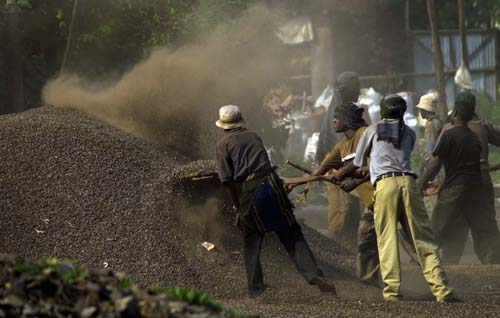
In his office above a furniture store in Addis Ababa, 2 1/2 days’ drive to the northeast, the agricultural manager for Ethio Agri-CEFT, Biru Abebe, said he was unaware of any complaints.
“Everybody goes and gets treatment,” he said.
That even includes the native tribe, said Tekle, the commercial manager, a claim that exceeds that of Starbucks. “They are people of the environment so the farm has to give assistance.”
But tribal member Yatola said the Shabuyye who live just downstream cannot get health care. “The company just gives medical attention to people who work for the company,” he charged.
Sitting in a stick hut, Yatola looked pensive. “We were isolated before. We didn’t interact with anyone,” he said as women outside pounded grain into mash with heavy wooden sticks. “But since the company has come, the road has acquainted us with the outside world.”
Outsiders show up along the river, catching fish that feed the tribe, Yatola said. “There are less fish – and more people fishing,” he said. “When we hear that the company, the way they have operated, they have created a nice relationship with the community, we know it’s not true.”
What’s unfolding in the Gemadro region is not unique. An article in the April 2007 Journal of Agrarian Change points out that as coffee growing expands in southwest Ethiopia, the ecology can suffer.
“Environmental degradation is a serious concern with rates of deforestation estimated at 10,000 hectares per year (25,000 acres) in the coffee growing areas,” the article said. “High levels of river pollution are also a major problem near coffee pulping and washing stations.”
During the fall harvest, Yatola said, coffee processing pulp appears in the river from somewhere upstream. “The river becomes black, almost like oil,” he said. “It smells like a dead horse.”
Abebe, Ethio Agri-CEFT’s agricultural manager, said the plantation has a lagoon to control pollution, that no waste flows from the Gemadro Estate. “The river is clean throughout the year. There is no pollution from our farm,” he said. “Zero.”
However, plantation manager Shiferaw said that not long ago valuable coffee beans did show up in the estate’s wastewater lagoon, where a handful of workers and area farmers had dumped them in a failed theft attempt. “They are in prison now,” he said.
In late February, four months after the bustling coffee harvest season, the Gemadro River looked clean. But in one of the ankle-deep side streams flowing into it, a white truck used to haul coffee was parked in the silvery water, being scrubbed of dirt and grease – a different but obvious pollution source.
“Sometimes it happens,” acknowledged Tekle, the commercial manager.
“We don’t have any control over that,” Abebe said. “That road, though we made it, is a public road, so any truck can go and come.”
Deforestation takes a toll
Although public, the road into the Gemadro Estate felt private. Armed guards checked vehicles entering or leaving to prevent coffee smuggling.
A row of rusty metal shacks looked like tool sheds, but were in fact worker housing. Even Shiferaw, the plantation manager, acknowledged they were not adequate.
“Yes, some is not. OK?” he said. “But we have a program to improve. When you see the standards of the country, it is better than most.”
Along the bumpy dirt road, waxy green rows of coffee trees sprouted in rows, shaded by clumps of taller trees that not long ago were part of a denser, more diverse forest.
To Tadesse Gole – an ecologist in Addis Ababa and a native Ethiopian whose doctoral thesis at the University of Bonn, Germany, focused on preservation of wild arabica coffee – that manicured landscape is a biological calamity.
“This is an Afromontane rain forest – an area of high plant diversity, of unique epiphytic plants that grow on the branches of trees,” Gole said. “We lose those plant species. And we lose many of the animals, birds and insects dependent on them.”
Gole is the author of a recent study about the environmental and cultural impacts of coffee and tea plantations in Ethiopia, including the Gemadro Estate. The estate has spawned a wave of imitators, Gole said: smaller coffee and tea farms that are toppling more trees.
The estate itself is growing, too.
Last year, the Ethiopian Herald cited the plantation’s project manager, Asenake Nigatu, telling the Ethiopian News Agency that Gemadro had “developed coffee on 1,000 hectares (about 2,470 acres) of land” it had obtained from the state investment bureau and had begun “activities to develop additional coffee on 1,500 hectares (about 3,700 acres) of land.”
Gole tapped the touchpad on his laptop. An image based on satellite photography popped up showing land use changes in the Gemadro region from 1973 to 1987. A small puddle of red blotches appeared, indicating deforested areas. Gole tapped again, bringing up an image through 2001 – three years after the plantation started. The red blotches had spread across the map, like measles. His eyes widened. “This is quite big,” he said.
In his study, prepared for a future book, Gole analyzed coffee planting and forest change across two woredas – local districts – in the Sheka Zone. “The area under forest cover has dropped significantly in all parts,” he wrote in the study. One area in particular stood out.
“The highest deforestation rate was observed in Gemadro, with (an) annual deforestation rate of 12.2 percent,” he wrote.
But Abebe, the Ethio-Agri CEFT agricultural manager, said Gole’s statements are misleading because the region was partially settled and cleared before the plantation came.
Ambassador Assefa agreed. “As I understand it, the land was largely cleared before Gemadro acquired the property,” he said.
In addition, Abebe said, Gemadro is helping the land recover by incorporating conservation principles into its practices. To bolster his point, he pointed to an award the estate recently received from the Southern Nations, Nationalities and Peoples’ Regional State for, he said, “being a model coffee farm.”
Those model practices include planting grasses and reeds to slow erosion, planting shade trees for coffee and leaving 3,200 acres untouched for wildlife, Abebe said, adding that they “have even planted indigenous trees in the appropriate areas.”
Gole, however, said such practices come up short. Many trees are non-native, he said, changing the composition of the forests. The plantation’s Web site says cover crops planted there include some from South America, Mexico and India.
Struggle over trademarks
The Ethiopian government’s advocacy for its coffee industry – as well as for tea and other rural developments – has drawn international concern about the fate of its highland rain forests. A 2007 article by two German scientists blamed a lack of consistent forest policies.
“Ethiopia’s montane rain forests are declining at an alarming rate,” scientists Carmen Richerzhagen and Detlef Virchow wrote in the International Journal of Biotechnology. “The absence of a land use policy in Ethiopia creates spontaneous decisions on land allocations in a disorganized manner – therefore the forest is always the one to suffer.”
But Ethiopia’s push to grow more coffee drew plenty of encouragement at a conference in Addis Ababa in February attended by representatives of the world’s leading coffee companies, including Starbucks.
At the time, Starbucks and Ethiopia were locked in a struggle over the government’s effort to trademark its famous coffee names – including Muel Alema’s Sidamo – to create a distinctive brand that could funnel more profits back to the countryside.
Starbucks fought the effort, saying geographical certification programs, such as those in place for Colombian coffees, keep prices higher by guaranteeing that coffee from Colombia really is from Colombia.
“A trademark does not do that,” said Hay, the Starbucks vice president, in a February interview in Addis Ababa. “It could be Sidamo and toilet paper. It doesn’t mean anything about the region or the quality.”
At times, the dispute turned bitter.
“What I don’t understand is why Starbucks is resisting this,” said Getachew Mengistie, director general of Ethiopia’s Intellectual Property Office. “They are for improving the lives of the farmers. We are for improving the lives of the farmers. Where is the problem?”
In May, the issue was resolved in the government’s favor, a positive step, said the ambassador.
“Starbucks is an important supporter of Ethiopia’s efforts to control our specialty coffee brands, and it is critical that our relationship isn’t about charity but about sound business,” Ambassador Assefa said. “While the company only buys a small fraction of Ethiopia’s coffee, our agreement will encourage market forces to allow Ethiopian farmers to capture a greater share of retail prices. This broad effort already has benefited thousands of poor farmers and could potentially benefit millions more.”
Who checked the plantation?
Improving the lives of farmers and the environment is the goal of many coffee certification systems, such as Fair Trade, Rain Forest Alliance and Smithsonian Bird-Friendly. The Gemadro Estate has been approved by the European-based Utz Certified, an organization started by a Dutch coffee roaster and Guatemalan growers.
“It’s good,” said Yehasab Aschale, Utz’s field representative in Ethiopia who said he toured the Gemadro plantation last year. “They are environmentally friendly. They are planting shade trees of the indigenous types. And they are improving the working conditions of the workers.”
Starbucks also gave the estate’s beans its own C.A.F.E. practices approval last year, signifying that the plantation protected the environment, paid workers fairly and provided them with decent housing.
Yet no one from Starbucks ever inspected the Gemadro plantation for C.A.F.E. certification. Dub Hay – the Starbucks global purchasing executive – said he knew little about the plantation because he hadn’t been there. Starbucks bought the coffee after tasting it in Europe, Hay said, adding that a coffee buyer from Switzerland visited at some point.
No one from the company Starbucks pays to oversee C.A.F.E. verification, Scientific Certification Systems of Emeryville, inspected Gemadro either. Instead, the plantation hired and paid an Africa-based company to do the job – a common industry practice.
Then, something out of the ordinary happened: The African company’s inspector was fired for doing a poor job, a fact that emerged only after The Bee asked about the verification process.
“Clearly, the inspector didn’t do as good, or as thorough, a job as is to be expected in C.A.F.E. practices,” said Ted Howes, vice president of corporate social responsibility for Scientific Certification Systems.
Howes declined to release a copy of the inspection report, but he said his company would visit the plantation this year. “There are issues we want to look at more closely,” he said.
Dennis Macray, Starbucks’ director of corporate responsibility, added that such problems “can happen in any kind of a system. … You can have something go wrong.”
If the C.A.F.E. certification process was flawed, why did Starbucks certify the beans?
“I can’t tell you,” Macray said at the Long Beach conference. With that, the trail went cold. Macray did not return follow-up calls. Starbucks spokeswoman Stacey Krum said details are confidential.
Krum, however, defended C.A.F.E. practices in general.
“There isn’t a standard code for the coffee industry; this is something we are learning as we go along,” she said. “And we are proud of it and confident it is achieving results.”
HOW THIS STORY WAS REPORTED
Bee reporter Tom Knudson spent three weeks in Ethiopia during his four months of reporting this story, including journeys to the Gemadro Estate, the Sidamo and Yirgacheffe regions, and an international coffee conference in Addis Ababa. He interviewed coffee farmers, plantation workers, tribal people, scientists and coffee industry leaders in Africa and the United States. And he reviewed dozens of studies, reports, books and scientific journal articles about coffee growing and marketing. Travel and research were underwritten by a grant from the Alicia Patterson Foundation in Washington, D.C.

